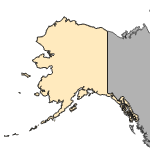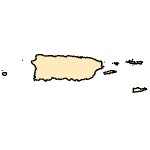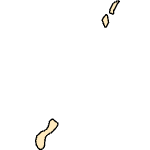Rhinoclemmys pulcherrima
(Painted Wood Turtle)
Reptiles-Turtles
Exotic |
|
Common name: Painted Wood Turtle
Synonyms and Other Names: Tortuga-de monte pintada
Taxonomy: available through
www.itis.gov
Identification: Rhinoclemmys pulcherrima is a mid-sized semi-terrestrial turtle possessing a brown, usually patterned, carapace with a rough appearance. The carapace is keeled mid-dorsally, posteriorly serrated, and exhibts raised growth rings (Ernst, 1981; Ernst and Barbour, 1989). The plastron (lower shell) is yellow with a dark central blotch or stripe (Ernst and Barbour, 1989). The head is brown to greenish and exhibits orange to red stripes (Ernst and Barbour, 1989).
Size: carapace length up to 20 cm (females) and 18 cm (males)
Native Range: The Painted Wood Turtle is found along the Pacific coast from Sonora, Mexico, to Costa Rica (Ernst and Barbour, 1989; Jolman, 2000; Ernst et al. 2012).



|

Alaska |

Hawaii |

Puerto Rico &
Virgin Islands |

Guam Saipan |
Hydrologic Unit Codes (HUCs) Explained
Interactive maps: Point Distribution Maps
Nonindigenous Occurrences:
Table 1. States with nonindigenous occurrences, the earliest and latest observations in each state, and the tally and names of HUCs with observations†. Names and dates are hyperlinked to their relevant specimen records. The list of references for all nonindigenous occurrences of Rhinoclemmys pulcherrima are found here.
Table last updated 7/26/2024
† Populations may not be currently present.
Ecology: The Painted Wood Turtle is found in moist woodlands and scrub often close to streams or ponds. The species also occurs in cleared or developed areas close to streams (Ernst and Barbour, 1989; Ernst et al. 2012). Rhinoclemmys pulcherrima consumes wildflowers, grasses, fruit, insects, worms, and fish (Ernst and Barbour, 1989; Jolman, 2000). It nests in leaf litter or soil and lays several clutches of three to five eggs during May to December (Jolman, 2000; Ernst et al. 2012).
Means of Introduction: The Massachusetts specimen was presumed to be a released or escaped pet (Cardoza et al., 1993), as is the Florida specimen.
Status: The collections presumably represent lone specimens, so the species is not established. Difficult to keep in captivity, it is unlikely that this species could become established in temperate climates (McCormick, 1998).
Impact of Introduction: The impacts of this species are currently unknown, as no studies have been done to determine how it has affected ecosystems in the invaded range. The absence of data does not equate to lack of effects. It does, however, mean that research is required to evaluate effects before conclusions can be made.
References: (click for full references)
Cardoza, J.E., G.S. Jones, T.W. French, and D.B. Halliwell. 1993. Exotic and translocated vertebrates of Massachusetts. Fauna of Massachusetts Series 6. Massachusetts Division of Fisheries and Wildlife, Westborough, MA.
Ernst, C.H. 1981. Emydidae: Rhinoclemmys pulcherrima. Catalogue of American Amphibians and Reptiles. American Society of Ichthyologists and Herpetologists. Herpetological Catalogue Committee (275)1-4.
Ernst, C.H., Altenburg, R.G.M., and Barbour, R.W. 2012. Turtles of the world: Accessed 8/12/2012 at: http://wbd.etibioinformatics.nl/bis/turtles.php?menuentry=inleiding.
Ernst, C.H. and R. W. Barbour. 1989. Turtles of the World. Smithsonian Institution Press. Washington D.C.
Jolman, M. 2000. Rhinoclemmys pulcherrima species account (online). Available at URL http://animaldiversity.ummz.umich.edu/accounts/rhinoclemmys/r._pulcherrima$narrative.html
Krysko, K.L., and 12 others. 2011. Verified non-indigenous amphibians and reptiles in Florida from 1863 through 2010—Outlining the invasion process and identifying invasion pathways and stages. Zootaxa: 3028:1—64.
McCormick, B. 1998. The Mexican Wood Turtle(On-line). Available at URL http://www.tortoise.org/archives/rhino.html
Author:
Fuller, P.L., and McKercher, L.
Revision Date: 6/29/2023
Citation Information:
Fuller, P.L., and McKercher, L., 2024, Rhinoclemmys pulcherrima (Gray, 1856): U.S. Geological Survey, Nonindigenous Aquatic Species Database, Gainesville, FL, https://nas.er.usgs.gov/queries/FactSheet.aspx?SpeciesID=1257, Revision Date: 6/29/2023, Access Date: 7/26/2024
This information is preliminary or provisional and is subject to revision. It is being provided to meet the need for timely best science. The information has not received final approval by the U.S. Geological Survey (USGS) and is provided on the condition that neither the USGS nor the U.S. Government shall be held liable for any damages resulting from the authorized or unauthorized use of the information.